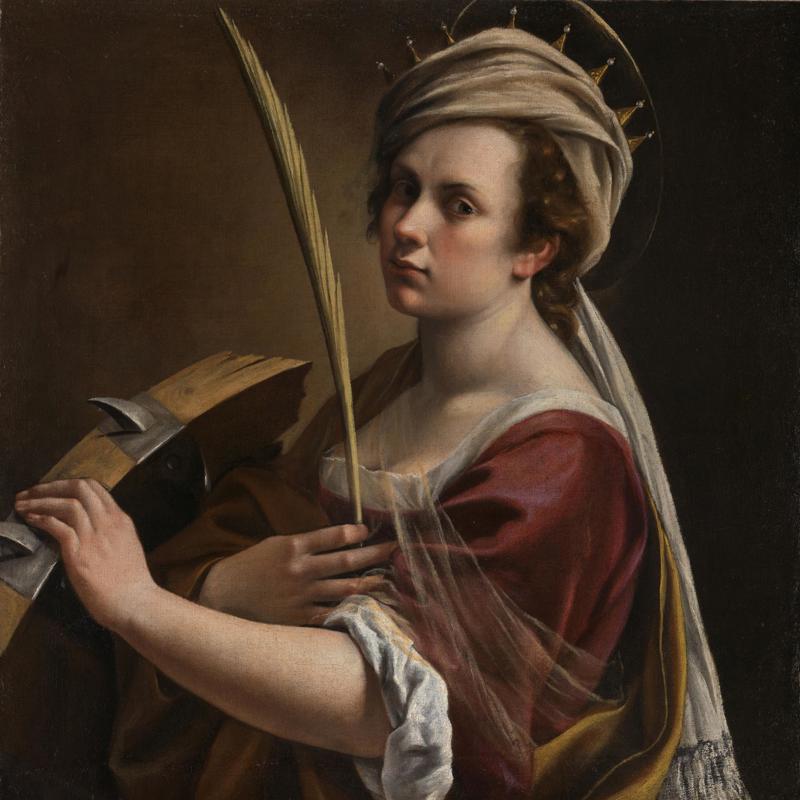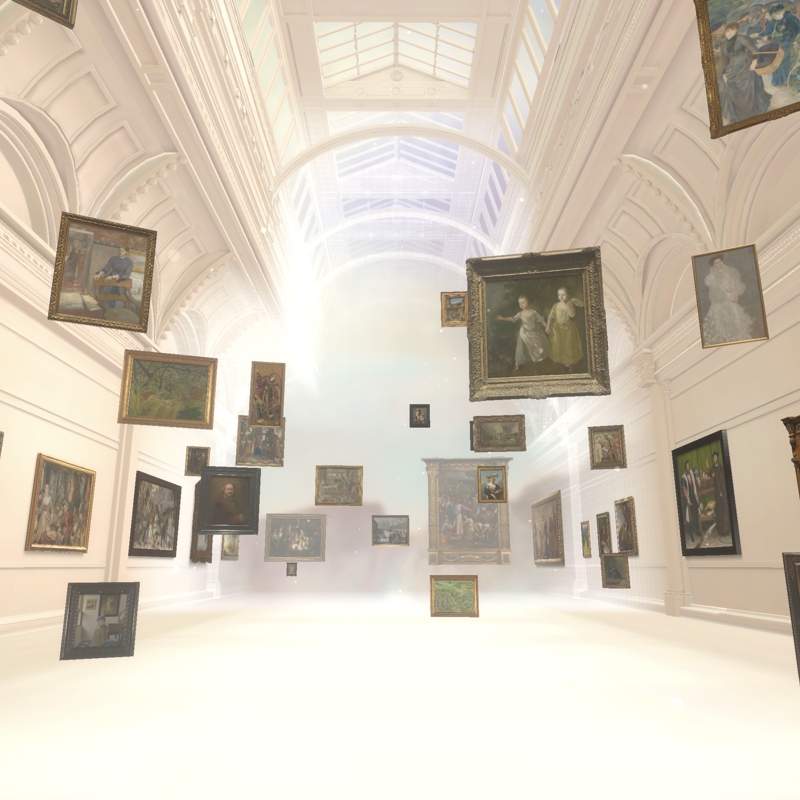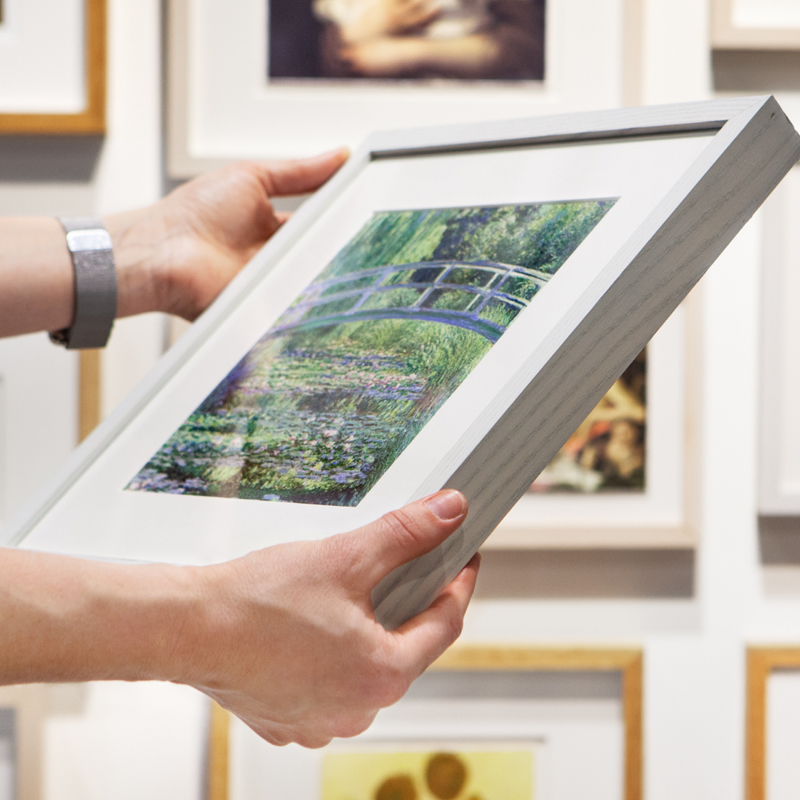Artemisia Gentileschi, 'Self Portrait as Saint Catherine of Alexandria', about 1615-17
About the work
Overview
Artemisia Gentileschi, the most celebrated female artist of the seventeenth century, appears in the guise of Saint Catherine of Alexandria, a Christian saint martyred in the early fourth century. She leans on a broken wheel studded with iron spikes, to which she was bound and tortured, and which became her standard attribute in art. Her right hand, delicately holding a martyr’s palm between thumb and forefinger, is brought to her chest.
The saint is portrayed as resilient, having endured torture – as indeed the artist herself did during the trial following her rape at the age of 17 by the painter Agostino Tassi. After the trial Artemisia moved from Rome to Florence, where this painting was probably made. She seems to have used her own image frequently in works she produced in Florence – a number of self portraits are known and others are recorded in seventeenth-century inventories. New to the city and keen to demonstrate her talent, she may have painted such pictures in a conscious act of self-promotion.
Audio description
Listen to an audio description of Artemisia Gentileschi's 'Self Portrait as Saint Catherine of Alexandria'
Transcript
This is an Audio Description of Self Portrait as Saint Catherine of Alexandria by Artemisia Gentileschi, it will take about eight minutes to listen to.
Artemisia Gentileschi is one of the most celebrated artists of the 17th century. She worked in Rome, Florence, Venice, Naples and London, and counted some of the leading European rulers of her time among her patrons. She was born in Rome in 1593, the daughter of Orazio Gentileschi - a famous painter and contemporary of Caravaggio. This accomplished oil painting is a realistic self-portrait of Artemisia in the guise of Saint Catherine of Alexandria. It was painted between 1615 and 1617 in Florence, where the artist created a number of self-portraits based on biblical figures.
Catherine was a Christian saint, martyred in the early 4th century. In the painting, the artist holds a martyr’s palm leaf in her right hand and leans against a broken, wooden wheel studded with iron spikes. The wheel was an instrument of torture used in public executions, and Saint Catherine was harnessed to one and condemned to death. According to legend, she was rescued by divine intervention, and the wheel became her symbol or attribute. Artemisia has deliberately chosen to use her own likeness for Saint Catherine whose strength and resolve, having withstood her torture, is evident.
The painting is contained within a tight square of approximately 70 cm. It depicts Artemisia from the waist to just above head height. This close cropping adds to the intensity of the composition. The artist gazes directly out at the viewer, with what The National Gallery curator Letizia Treves describes, as ‘resilience and quiet determination’.
Artemisia stands in the centre of the image against a sombre background of dark brown, which lightens to the left of the figure. She is dressed in a generous, deep red gown, with a heavy golden wrap draped over her right shoulder and wound about her waist. She is turned aside, her body facing the wheel on her right. It reaches up to shoulder height and is broken at the far end with jagged fissures in the wood. Due to the cropping of the composition, only the top part of the wheel is shown. This section has two sharp metal spikes. They are attached to strips of metal that are nailed to the inside of the wheel. The spikes are shaped like fat claws that face away from her. In the foreground, at the bottom of the painting, the artist reaches her left arm across to lightly support the wheel just above the front spike. Her thumb is hidden, tucked away in the shadows beneath the wheel. Her little finger brushes the side of the spike and her knuckles are rosy pink. Her right arm is pulled in tightly between the inside of the wheel and her chest. The back of her hand is turned outwards as she delicately holds the palm frond between thumb and forefinger, like a quill. Her other fingers are splayed against her bodice, her little finger obscured by her other sleeve. The palm leaf is a muted yellow and shaped like a long, narrow feather. It arcs away from Artemisia, its tip just inside the top edge of the frame. Her dark red dress is of a luxurious material with a deep sheen. It has a square neckline with a white collar and generous white cuffs which are loosely rolled back at her elbow. The collar has a narrow white frill at the front but is cut low enough to reveal the swell of her breast. A sheer scarf hangs from her right shoulder and sweeps across her décolletage, over her left arm.
Artemisia has pale, luminous skin. She gazes out through strong, hazel eyes under slim, dark, arching eyebrows. Her attractive face has soft, rounded features: a pert nose, a dimpled chin. Her shapely lips are pursed. Her cheeks are flushed. As she is turned aside, her left cheek and the left side of her neck are exposed: her left ear carefully delineated with shallow pink creases. On her head she wears a long, off-white scarf wrapped like a turban. The end of the scarf hangs down her back. Its silky fringe reaching the bottom edge of the painting. The turban is angled to reveal her full, pale forehead. At the sides, her chestnut curls are tucked back under the turban and gathered at the nape of her neck. Several wispy curls escape from the confines of the turban to cloud the edges of her cheeks. Protruding from the top of the turban are the radiating slender points of a gold crown. The crown has eight triangular points that each pierce a single glowing pearl. The highest pearl is just enclosed within the painting. Encircling the top of her head is a shimmering halo, most of which is visible within the frame.
The scene is depicted theatrically, lit from a source above. This illuminates the top of the wheel, the modelling of Artemisia’s outstretched arm and the smooth gleaming skin of her neck. To the rear of the figure is an inky darkness, which lightens to the figure’s right. The contrast with her lightly-toned turban, and skin, has the effect of offsetting her face. The inside of the wheel is in shadow as are the creases in the deep folds of her garments. The painting is enclosed within a 17th-century Tuscan frame that is about 20 cm wide. The frame is black with gold-painted borders and painted decorative patterns at the four corners, with delicate gold flower motifs in between.
The painting dates from Artemisia’s period of activity in Florence, where she moved from Rome in 1612, following her rape by Agostino an acquaintance of her father. During the infamous trial that ensued Artemisia testified and was subjected to physical torture. Tassi was convicted (though his banishment from Rome was never enforced). Following the trial Artemisia married and moved to Florence, where she established herself as an independent artist, becoming the first woman to gain membership to the Academy of the Arts of Drawing. Artemisia used her own image frequently in her works which may have been a conscious act of self-assertion. She became highly regarded and by the time she returned to Rome in 1620 her paintings were in great demand. In 1630 Artemisia settled in Naples where she ran a studio together with her daughter Prudenzia and continued to enjoy considerable success. She briefly visited London in 1639, possibly to assist her father on a series of ceiling paintings for the Queen’s House at Greenwich - which are now installed at Marlborough House in London – but she returned to Naples the following year. The precise date of her death is not known.
Some of her paintings have been read in biographical terms, especially scenes featuring a strong female heroine. Her most famous work Judith Beheading Holofernes has been interpreted as her pictorial revenge on Tassi. Though it is debatable whether such works were specifically produced as creative responses to her assault, there is no question that Artemisia’s personal identity is closely intertwined with her art. Artemisia was admired during her lifetime but was forgotten over the following centuries and has only been duly re-evaluated over the last fifty years.
Key facts
Details
- Full title
- Self Portrait as Saint Catherine of Alexandria
- Artist
- Artemisia Gentileschi
- Artist dates
- 1593 - 1654 or later
- Date made
- about 1615-17
- Medium and support
- oil on canvas
- Dimensions
- 71.4 × 69 cm
- Acquisition credit
- Bought with the support of the American Friends of the National Gallery, the National Gallery Trust, Art Fund (through the legacy of Sir Denis Mahon), Lord and Lady Sassoon, Lady Getty, Hannah Rothschild CBE, Mrs Mollie W. Vickers, the Hon. Mrs Ashley Dawson-Damer, The Society of Dilettanti Charitable Trust Fund, Mr Andrew Green QC and Ms Hirschl, Mr Matthew Santos and Mrs Mary Kuusisto, Mr Peter Scott CBE QC and Dr Richard Ballantine, the Diane Apostolos-Cappadona Trust, Mr Stephen Allcock, Mr James and Lady Emma Barnard, Miss Maxine White and Mr James Mortimer, Michael and Felicia Crystal, The W T J Griffin Charitable Settlement and other donors including those who wish to remain anonymous, 2018
- Inventory number
- NG6671
- Location
- Room 32
- Collection
- Main Collection
- Frame
- 17th-century Italian Frame
Provenance
Additional information
This painting is included in a list of works with incomplete provenance from 1933–1945; for more information see Whereabouts of paintings 1933–1945.
Text extracted from the ‘Provenance’ section of the catalogue entry in ‘National Gallery Catalogues: Online Entries’, London 2024; for further information, see the full catalogue entry.
Exhibition history
-
2019Artemisia visitsGlasgow Women's Library6 March 2019 - 19 March 2019Pocklington General Practice29 April 2019 - 11 May 2019Sacred Heart Catholic High School14 May 2019 - 17 May 2019HMP Send20 May 2019 - 22 May 2019Wood Street Library1 June 2019 - 16 June 2019
-
2020ArtemisiaThe National Gallery (London)3 October 2020 - 24 January 2021
-
2021By Her Hand: Artemisia Gentileschi and Women Artists in Italy, 1500–1800Wadsworth Atheneum Museum of Art30 September 2021 - 9 January 2022The Detroit Institute of Arts6 February 2022 - 29 May 2022
-
2022Artemisia Gentileschi in NaplesGallerie d'Italia - Palazzo del Banco di Napoli1 December 2022 - 20 March 2023
-
2024National TreasuresIkon Gallery10 May 2024 - 8 September 2024
Bibliography
-
1989M.D. Garrard, Artemisia Gentileschi: The Image of the Female Hero in Italian Baroque Art, Princeton 1989
-
1993G.L. Hersey, 'Female and Male Art: "Postille" to Garrard's "Artemisia Gentileschi"', in J. Chenault Porter and S.C. Scott Munshower (eds), Parthenope's Splendor: Art of the Golden Age in Naples, Papers in Art History from the Pennsylvania State University 7, University Park PA 1993, pp. 322-35
-
1993J. Chenault Porter and S.C. Scott Munshower (eds), Parthenope’s Splendor: Art of the Golden Age in Naples, Papers in Art History from the Pennsylvania State University 7, University Park PA 1993
-
1998A. Lapierre, Artemisia: Un duel pour l'immortalité, Paris 1998
-
1999R.W. Bissell, Artemisia Gentileschi and the Authority of Art: Critical Reading and Catalogue Raisonné, University Park PA 1999
-
2000G. Papi, 'Review: Artemisia Gentileschi and the Authority of Art by Roger Ward Bissell', The Burlington Magazine, CXLII/1168, July 2000, pp. 452-3
-
2001K. Christiansen and J.W. Mann (eds), Orazio and Artemisia Gentileschi (exh. cat. Metropolitan Museum of Art, 14 Februrary 2002 - 12 May 2002), New York 2001
-
2001E. Cropper, 'Life on the Edge: Artemisia Gentileschi, Famous Woman Painter', in K. Christiansen and J.W. Mann (eds), Orazio and Artemisia Gentileschi, New York 2001, pp. 263-81
-
2005M. Bal, 'Grounds of Comparison', in M. Bal (ed.), The Artemisia Files: Artemisia Gentileschi for Feminists and Other Thinking People, Chicago 2005, pp. 138-43
-
2005J.W. Mann, 'The Myth of Artemisia as a Chameleon: A New Look at the London Allegory of Painting', in J.W. Mann (ed.), Artemisia Gentileschi: Taking Stock, Turnhout 2005, pp. 51-77
-
2006C. Seccaroni, Giallorino: Storia dei Pigmenti Gialli di Natura Sintetica, Rome 2006
-
2011F. Paliaga, 'Una Santa Caterina di Artemisia Gentileschi', Storia dell’arte, CXXIX, 2011, pp. 56-63
-
2014S. Barker, 'A New Document Concerning Artemisia Gentileschi's Marriage’, The Burlington Magazine, CLVI, 2014, pp. 803-4
-
2015J.M. Locker, Artemisia Gentileschi: The Language of Painting, New Haven 2015
-
2016Mancini, Giorgia, and Nicholas Penny, National Gallery Catalogues: The Sixteenth Century Italian Paintings, 3, Bologna and Ferrara, London 2016
-
2017G. Papi, 'Mary Magdalene in Ecstasy and the Madonna of the Svezzamento: Two Masterpieces by Artemisia', in S. Barker (ed.), Artemisia Gentileschi in a Changing Light, Turnhout 2017, pp. 147-66
-
2019National Gallery, The National Gallery: Review of the Year, April 2018 - March 2019, London 2019
-
2019L. Keith et al., 'Artemisia Gentileschi's Self Portrait as Saint Catherine of Alexandria', National Gallery Technical Bulletin, XL, 2019, pp. 4-17
-
2019C. Frosinini and M.L. Reginella, 'Artemisia Gentileschi, la Santa Caterina d’Alessandria delle Gallerie degli Uffizi. Nuove acquisizioni dalle indagini diagonistiche', OPD Restauro, 31, 2019, pp. 109-21
-
2019L. Treves, 'Artemisia Gentileschi’s Self Portrait as Saint Catherine of Alexandria', in The National Gallery: Review of the Year April 2018 - March 2019, London 2019, pp. 12-3
-
2020L. Treves, Artemisia (exh. cat., The National Gallery, London), London 2020
-
2020C. Fryklund and L. Dahlén, 'Acquisitions / Artemisia Gentileschi's Saint Catherine of Alexandria', Art Bulletin of Nationalmuseum, XXVII/2, 2020, pp. 13-22
-
2020M.D. Garrard, Artemisia Gentileschi and Feminism in Early Modern Europe, London 2020
-
2020L. Keith, 'Looking at Artemisia', in L. Treves (ed.), Artemisia, London 2020, pp. 90-105
-
2020L. Treves,'Artemisia Portraying Her Self', in L. Treves (ed.), Artemisia, London 2020, pp. 64-77
-
2021S. Barker, Artemisia Gentileschi (Illuminating Women Artists), London 2021
-
2021F. Solinas, Lettere di Artemisia, Florence 2021
-
2021E. Straussman-Pflanzer and O. Tostmann (eds), By Her Hand: Artemisia Gentileschi and Women Artists in Italy, 1500-1800 (exh. cat. Wadsworth Atheneum Museum of Art, 30 September 2021 - 9 January 2022; Detroit Institute of Arts, 6 February 2022 - 29 May 2022), New Haven 2021
-
2024The National Gallery, National Gallery Catalogues: Online Entries for Individual Paintings, London 2024
Frame
This seventeenth-century Italian reverse-moulded frame is crafted from poplar wood. It retains its original ebonised glossy finish, accented with gilded fillets on the mouldings surrounding the frieze. The frieze features oil-gilded ornaments at the corners and the centres: at the corners are scrolling foliate motifs, and the centres have a daisy-like flower head. Both motifs are accentuated with dotted lines along their edges.
This frame was fitted to Gentileschi’s Self Portrait as Saint Catherine of Alexandria in 2000.
About this record
If you know more about this work or have spotted an error, please contact us. Please note that exhibition histories are listed from 2009 onwards. Bibliographies may not be complete; more comprehensive information is available in the National Gallery Library.



